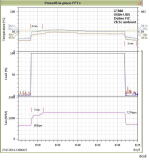I’m looking for advice on how to best cool a stock AMD Threadripper 2950x when married with the Noctua NH-U14s-TR4-SP3 CPU cooler – I’ve seen a few posts online covering the issue, but I’ve yet to find a suitable solution to the CPU running hot.
I’ve also moved my HDD’s so they sit at the bottom of the case ensuring a good flow from the chassis fans on the front of the case through to the CPU cooler.
Any advice or suggestions would be greatly appreciated.
Thanks
- AMD Threadripper 2950x
- Noctua NH-U14s-TR4-SP3 CPU Cooler + additional Noctua NF-A15 140mm CPU Fan
- Asrock Taichi x399 Motherboard
- 32GB Corsair Vengence LPX 3200 MHz RAM (4×8GB)
- Fractal Design R6 with 3 stock chassis fans
- EVGA G3 1000w PSU – 80 Plus Gold
- Nvidia GTX 750 Ti
- Samsung 970 EVO M.2 /Samsung SSD 840 PRO / SanDisk Ultra II SSD + HDD's + DVD Drive
- Temperature
- Idle temperature on boot is approximately 24, spiking to 30 degrees (ambient room temperature is between 19 and 22 degrees).
- After 10 minutes sat idle, the temperature may slowly rise to around 45, spiking upwards of 55 degrees at times.
- Under full load the temperature reaches around 60 degrees fairly quickly and continues to slowly creep up by one degree every few minutes. Once the temp hit’s 63 – 65 degrees I’ll stop it as it shows little evidence that it will stop rising.
- Peak Speed
- Peak Speed consistently bounces around between 2.200 GHz and 4.150 GHz.
- Peak Speed consistently bounces around between 2.200 GHz and 4.150 GHz.
- CPU Voltage
- The CPU Voltage consistently bounces around between 0.7625 and 1.3600.
- The CPU Voltage consistently bounces around between 0.7625 and 1.3600.
I’ve also moved my HDD’s so they sit at the bottom of the case ensuring a good flow from the chassis fans on the front of the case through to the CPU cooler.
Any advice or suggestions would be greatly appreciated.
Thanks





